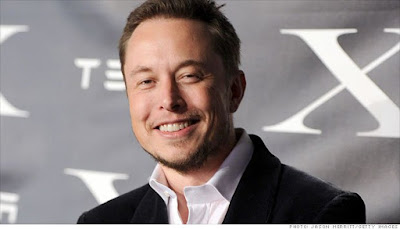Meet the Great Elon Musk - Engineer, Inventor, Explorer and the Messiah!!!
South African
entrepreneur Elon Musk is known for founding Tesla Motors and SpaceX, which
launched a landmark commercial spacecraft in 2012.
QUOTES
“I'm very pro-environment, but let's figure out how to do
it better and not jump through a dozen hoops to achieve what is obvious in the
first place.”
—Elon
Musk
Born in South Africa in 1971, Elon Musk became a
multimillionaire in his late 20s when he sold his start-up company, Zip2, to a
division of Compaq Computers. He achieved more success by founding X.com in
1999, SpaceX in 2002 and Tesla Motors in 2003. Musk made headlines in May 2012
when SpaceX launched a rocket that would send the first commercial vehicle to
the International Space Station.
Born and raised in South Africa, Elon Musk purchased his
first computer at age 10. He taught himself how to program, and when he was 12
he made his first software sale—of a game he created called Blaster. At age 17,
in 1989, he moved to Canada to attend Queen’s University, but he left in 1992
to study business and physics at the University of Pennsylvania. He graduated
with an undergraduate degree in economics and stayed for a second bachelor’s
degree in physics.
After leaving Penn, Elon Musk headed to Stanford University
in California to pursue a Ph.D in energy physics. However, his move was timed
perfectly with the Internet boom, and he dropped out of Stanford after just two
days to become a part of it, launching his first company, Zip2 Corporation.
An online city guide, Zip2 was soon providing content for
the new Web sites of both the New York Times and the Chicago Tribune, and in
1999, a division of Compaq Computer Corporation bought Zip2 for $307 million in
cash and $34 million in stock options.
Also in 1999, Musk co-founded X.com, an online financial
services/payments company. An X.com acquisition the following year led to the
creation of PayPal as it is known today, and in October 2002, PayPal was
acquired by eBay for $1.5 billion in stock. Before the sale, Musk owned 11
percent of PayPal stock.
"If I’m trying to solve a problem, and I think I’ve
got some elements of it kind of close to being figured out, I’ll pace for hours
trying to think it through."
Never one to rest on his laurels, Musk founded his third
company, Space Exploration Technologies Corporation, or SpaceX, in 2002 with
the intention of building spacecraft for commercial space travel. By 2008,
SpaceX was well established, and NASA awarded the company the contract to
handle cargo transport for the International Space Station—with plans for
astronaut transport in the future—in a move to replace NASA’s own space shuttle
missions.
The boundless potential of space exploration and the
preservation of the future of the human race have become the cornerstones of
Musk's abiding interests, and toward these he has founded the Musk Foundation,
which is dedicated to space exploration and the discovery of renewable and
clean energy sources.
Tesla Motors
Another Musk venture is Tesla Motors, a company dedicated to
producing affordable, mass-market electric cars. Five years after its
formation, the company in 2008 unveiled the Roadster, a sports car capable of
accelerating from 0 to 60 mph in 3.7 seconds, as well traveling nearly 250
miles between charges of its lithum ion battery. With a stake in the
company taken by Daimler and a strategic partnership with Toyota, Tesla Motors
launched its initial public offering in June 2010, raising $226 million.
Additional successes include the Model S, the company's
first electric sedan. Capable of covering 265 miles between charges, the Model
S was honored as the 2013 Car of the Year by Motor Trend magazine.
Preparing for Lift-Off
On May 22, 2012, Musk and SpaceX made history when the
company launched its Falcon 9 rocket into space with an unmanned capsule. The
vehicle was sent to the International Space Station with 1,000 pounds of
supplies for the astronauts stationed there, marking the first time a private
company had sent a spacecraft to the International Space Station. Of the
launch, Musk was quoted as saying, "I feel very lucky. ... For us, it's
like winning the Super Bowl."
In December 2013, SpaceX notched another milestone when
Falcon 9 carried a satellite to geosynchronous transfer orbit, a distance at
which the satellite would lock into an orbital path that matched the Earth's
rotation. In February 2015, SpaceX launched another Falcon 9 fitted with
the Deep Space Climate Observatory (DSCOVR) satellite, aiming to observe the
extreme emissions from the sun that affect power grids and communications
systems on Earth.
Musk has continued his work in attempting to make his
innovative ideas a reality. In August 2013, he released a concept for a new
form of transportation called the "Hyperloop," an invention that
would foster commuting between major cities while severely cutting travel time.
Ideally resistant to weather and powered by renewable energy, the Hyperloop
would propel riders in pods through a network of low-pressure tubes at
speeds reaching more than 700 mph. Musk noted that the Hyperloop
could take from seven to 10 years to be built and ready for use.
Although he introduced the Hyperloop with claims that it
would be safer than a plane or train, with an estimated cost of $6
billion—approximately one-tenth of the cost for the rail system planned by the
state of California—Musk's concept has drawn skepticism. Nevertheless, the
entrepreneur has sought to encourage the development of this idea. In June 2015,
he announced a competition for teams to submit their designs for a Hyperloop
pod prototype, with participants getting the chance to test their creations on
a track at the SpaceX facility in June 2016.
